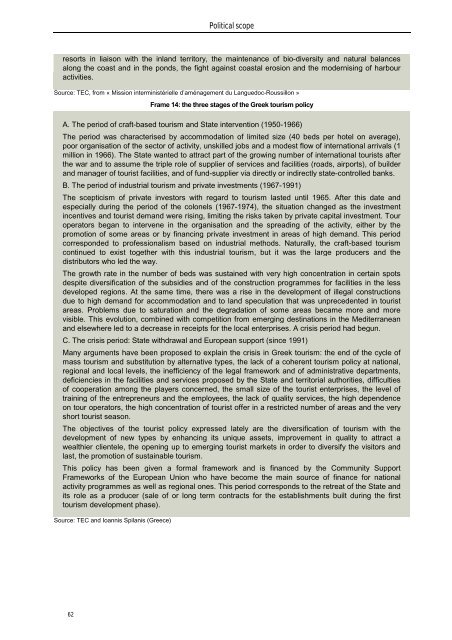dossier sur le tourisme et le développement durable
dossier sur le tourisme et le développement durable
dossier sur le tourisme et le développement durable
Create successful ePaper yourself
Turn your PDF publications into a flip-book with our unique Google optimized e-Paper software.
62<br />
Political scope<br />
resorts in liaison with the inland territory, the maintenance of bio-diversity and natural balances<br />
along the coast and in the ponds, the fight against coastal erosion and the modernising of harbour<br />
activities.<br />
Source: TEC, from « Mission interministériel<strong>le</strong> d’aménagement du Languedoc-Roussillon »<br />
Frame 14: the three stages of the Greek tourism policy<br />
A. The period of craft-based tourism and State intervention (1950-1966)<br />
The period was characterised by accommodation of limited size (40 beds per hotel on average),<br />
poor organisation of the sector of activity, unskil<strong>le</strong>d jobs and a modest flow of international arrivals (1<br />
million in 1966). The State wanted to attract part of the growing number of international tourists after<br />
the war and to assume the trip<strong>le</strong> ro<strong>le</strong> of supplier of services and facilities (roads, airports), of builder<br />
and manager of tourist facilities, and of fund-supplier via directly or indirectly state-control<strong>le</strong>d banks.<br />
B. The period of industrial tourism and private investments (1967-1991)<br />
The scepticism of private investors with regard to tourism lasted until 1965. After this date and<br />
especially during the period of the colonels (1967-1974), the situation changed as the investment<br />
incentives and tourist demand were rising, limiting the risks taken by private capital investment. Tour<br />
operators began to intervene in the organisation and the spreading of the activity, either by the<br />
promotion of some areas or by financing private investment in areas of high demand. This period<br />
corresponded to professionalism based on industrial m<strong>et</strong>hods. Naturally, the craft-based tourism<br />
continued to exist tog<strong>et</strong>her with this industrial tourism, but it was the large producers and the<br />
distributors who <strong>le</strong>d the way.<br />
The growth rate in the number of beds was sustained with very high concentration in certain spots<br />
despite diversification of the subsidies and of the construction programmes for facilities in the <strong>le</strong>ss<br />
developed regions. At the same time, there was a rise in the development of il<strong>le</strong>gal constructions<br />
due to high demand for accommodation and to land speculation that was unprecedented in tourist<br />
areas. Prob<strong>le</strong>ms due to saturation and the degradation of some areas became more and more<br />
visib<strong>le</strong>. This evolution, combined with comp<strong>et</strong>ition from emerging destinations in the Mediterranean<br />
and elsewhere <strong>le</strong>d to a decrease in receipts for the local enterprises. A crisis period had begun.<br />
C. The crisis period: State withdrawal and European support (since 1991)<br />
Many arguments have been proposed to explain the crisis in Greek tourism: the end of the cyc<strong>le</strong> of<br />
mass tourism and substitution by alternative types, the lack of a coherent tourism policy at national,<br />
regional and local <strong>le</strong>vels, the inefficiency of the <strong>le</strong>gal framework and of administrative departments,<br />
deficiencies in the facilities and services proposed by the State and territorial authorities, difficulties<br />
of cooperation among the players concerned, the small size of the tourist enterprises, the <strong>le</strong>vel of<br />
training of the entrepreneurs and the employees, the lack of quality services, the high dependence<br />
on tour operators, the high concentration of tourist offer in a restricted number of areas and the very<br />
short tourist season.<br />
The objectives of the tourist policy expressed lately are the diversification of tourism with the<br />
development of new types by enhancing its unique ass<strong>et</strong>s, improvement in quality to attract a<br />
wealthier cliente<strong>le</strong>, the opening up to emerging tourist mark<strong>et</strong>s in order to diversify the visitors and<br />
last, the promotion of sustainab<strong>le</strong> tourism.<br />
This policy has been given a formal framework and is financed by the Community Support<br />
Frameworks of the European Union who have become the main source of finance for national<br />
activity programmes as well as regional ones. This period corresponds to the r<strong>et</strong>reat of the State and<br />
its ro<strong>le</strong> as a producer (sa<strong>le</strong> of or long term contracts for the establishments built during the first<br />
tourism development phase).<br />
Source: TEC and Ioannis Spilanis (Greece)
















